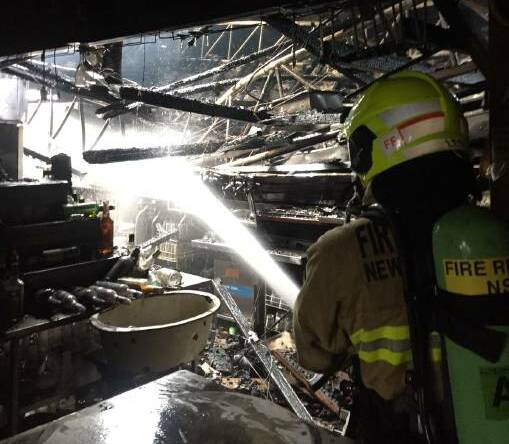
A NEW England hotel was deliberately torched in 2016 but a coroner has been unable to determine who poured the petrol and set fire to the building.
Subscribe now for unlimited access.
$0/
(min cost $0)
or signup to continue reading
The Armidale Club was destroyed and reduced to charred remains after an explosion sparked a blaze in the Beardy Street building just before dawn on September 16, 2016.
Following an inquest in Armidale Coroner’s Court, coroner Michael Holmes delivered his findings, ruling the fire was deliberate.
A certain flammable substance, namely petrol, was poured within that premises and ignited by a person or persons unknown.
- Coroner Michael Holmes
“A certain flammable substance, namely petrol, was poured within that premises and ignited by a person or persons unknown,” he said.
New England detectives had been investigating the explosion and subsequent fire, which broke out about 5am, before it was referred to the coroner.
Mr Holmes said the inquest was needed because of “the suspicious circumstances surrounding the fire, the extent of the damage to the premises and the general public interest”.
The court was told about 1am on September 16, the internal wood fire was extinguished and the premises were “secured and locked” by the club’s manager and licensee.
The court heard the single-story, timber-cladded club had an alarm system and numerous CCTV camera installed, but the alarms weren’t monitored.
A fire, lit in the front bar of the club spread to the roof cavity, activated the alarm at 5am but “the monitoring company did not respond to the alarm”.
A passerby called triple zero at 5.15am, sparking the response by police and NSW Fire and Rescue.
“As a result of the fire, internal sections of the roof have collapsed into the bar and lounge area, there was, a secondary roof collapse in the bathroom areas,” Mr Holmes said in his findings.
Internal walls were destroyed and a large “metal support beam across the width of the roof gave way, the remainder of the club was damaged extensively by water and/or smoke”.
“There was an article of clothing wrapped around a hard object,” Mr Holmes said.
“This window was likely to have broken by force prior to the fire.”
Forensic officers examined the remains of the club and an analysis certificate “identified petrol being present in certain material under examination”.
The court heard investigators had trouble obtaining nearby CCTV footage from homes and businesses and either “were not given access”, encountered problems with file formats or could not secure the footage.
Mr Holmes said the club was in competition with other licensed venues and there had been suggestions a “competitor may have taken action to burn the club down in an effort to eliminate competition”.
Mr Holes said he found “no evidence to lead me to that conclusion or to eliminate such a conclusion”.
Police have not found any evidence connecting any identifiable person or persons as a subject of interest.
- Coroner Michael Holmes
“Police have not found any evidence connecting any identifiable person or persons as a subject of interest,” he said in his findings.
The club’s manager said the premises was broken into the day before the fire, a window was found ajar, “a shoe located in the building and the contents of the lost and found draw scattered on a bench”.
The court heard the break-in was not reported but was revealed during the police investigation into the fire because the manager was going to review CCTV of the incident.
The court was told there was no current financial issues, the club was trading profitably but a former contractor and club employee who had suicided was a co-incidence and “his death was related to unresolved personal issues”.
The club was granted a general hotel licence on August 31, 2016.


